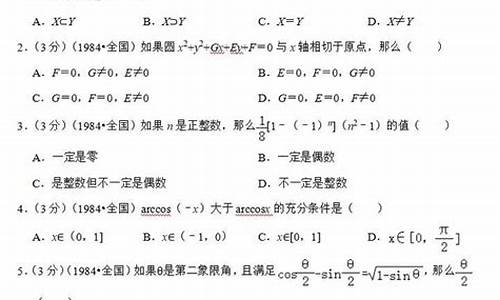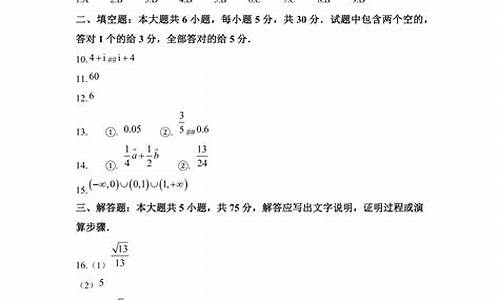非谓的高考题_高考非谓语
1.高考英语 非谓语的一道题目, 关于serve的
2.非谓语动词
3.一道高考英语一模语法题
4.高考的语法题中如何区分位于动词和非谓语动词
5.非谓语做定语主被动如何判断 详细介绍下,别含糊不清,最好有万能的方法

这个题目我做过,那是应该是做错了的,记得是个高考题,当时也很纠结,并且现在还是不太会,下面是从网上找的解析,但愿对你有帮助。
1)找出逻辑主语。就是句子的主语farmers
2) 判断逻辑主语与非谓语动词之间的主被动关系。这里显然是被动关系。
3)根据句意及非谓语动词的特点选出正确选项。being driven 表示现在正在进行的被动动作,或与主语谓语动词同时发生的被动动作。而过去分词只强调被动,不注重其时间上的先后还是同时发生。这里主句用的是现在完成时,时态上是后于现在后于现在进行的,故而前一句对,那么,后一句就错了。
style="font-size: 18px;font-weight: bold;border-left: 4px solid #a10d00;margin: 10px 0px 15px 0px;padding: 10px 0 10px 20px;background: #f1dada;">高考英语 非谓语的一道题目, 关于serve的
这题我刚做过,你的选项比我的简单
分析如下:整句话翻译为:除非你已经种植过了,否则你不可能懂得看着你种植的指物生长时的快乐。(含义是“经历之后才会懂”)
核心部分是watch the thing (you have planted)do/doing(你问做什么成分。它做的是做宾补)
括号内为thing的定语从句;光从语法上来说,可以使用do的形式,也可以是doing的形式,所以空格处可以填grow或growing。然后,从逻辑上来说,填grow比growing更合适恰当,因为填原形的含义是“侧重于整个过程”,而现在分词则侧重于动作正在发生。显然原句指的是整个种植的过程,不止于某一时刻的进行。所以原题要选grow,但如果没有grow的话,退而求其次,选growing
非谓语动词
serving的原型是serve 动词可以解释为服务 作为宗教仪式的中心舞台来服务
servered的原型是server 而server字典上只能做n.不能做v.所以不存在被动
就算要被动 应该是perhaps being served as
一道高考英语一模语法题
高考英语语法专题讲解-主谓一致
★着重讲解混搭情况,均遵守以下原则:
1. 意义一致原则
主语后跟有以下引起的短语:谓语动词仍与短语前的主语的形式保持一致。
1.1 (together) with: Alice (together) with her parents often goes to the park on Sundays.
1.2 except/but: Every picture except/ but these two has been sold.
Nobody but Mary and I was in the classroom at that time.
1.3 no less than: His sister, no less than you, is wrong.
1.4 rather than: The father, rather than the brothers, is responsible for the accident.
1.5 perhaps : Peter, perhaps John, is playing with the little dog.
1.6 like: He, like you and Xiao Liu is very diligent.
1.7 including/ besides/ as well as
2. 就近原则
2.1 主语由以下连词连接:谓语动词与后一个主语一致:
2.2.1(Either)…or…: Either you or I am going to the movies.
2.2.2 Neither…nor…
2.2.3 Whether…or…
2.2.4 Not only…but (also)
2.2.5 Not…but…
2.2 there be 句型: be 动词与后面第一个名词一致
E.g. There is an apple, two bananas and some oranges on the plates.
2.3副词here, there, now, then, up, down, in, out, away, such连接的全部倒装结构中:谓语动词由动词后面的主语决定
On the wall hang two maps. 墙上挂着两张地图。
On the wall hangs a world of map. 墙上挂着一张世界地图。
Such is the result. 结果就是这样。
Such are the results. 这就是结果
3. 整体原则
3.1 并列主语如果指的是同一个人、同一事物或同一概念时,谓语动词用单数,and后面的名词没有冠词:
The writer and worker is coming to our school tomorrow.
(一个人)
The writer and the worker are coming to our school tomorrow.
(两个人)
Bread and butter is their daily food.
3.2表示时间、距离、价格、度量衡等的复数名词或短语作为一个整体看待时,谓语动词常用单数形式:
E.g. Three years is not a long time.
Ten dollars is what he needs.
Five hundred miles is a long distance.
3.3复数形式的专有名词作为整体看待(人名、地点、国家、组织、书籍、报刊等),动词用单数形式:
E.g. The United Nations has passed a resolution(决议)。
“The Arabian Nights”(《天方夜谭》)is an interesting book.
3.4集合名词people, police ,cattle作主语,谓语动词用复数形式:
E.g. The police are searching for him.
The cattle are grassing (吃草)。
4. 谓单原则
4.1 and连接的并列单数名词前如有each, every, no修饰时,谓语动词要用单数形式。
E.g. Every boy and girl has been invited to the party.
No teacher and no student is absent today.
Many a student is busy with their lessons.
4.2 用many a, more than one 修饰名词时,谓语动词要用单数形式。
E.g. More than one person has made the suggestion.
Many a rough man has been civilized by his wife.
4.3 Each, Either, One, Another, The other, Neither作主语时,谓语动词用单数形式:
E.g. Each takes a cup of tea.
Either is correct.
4.4 由every, some, any, no构成的合成代词作主语时,谓语动词用单数形式:
E.g. Nothing is to be done.
4.5 means, politics, physics, plastics作主语时,谓语动词用单数形式.
5. 具体情况原则
5.1 all, few, more, most, some, any, none, half, the rest等作主语时,既可表示复数意义,也可表示单数意义,谓语动词要根据实际情况而定:
All of the apple is rotten. 整个苹果都烂了。
不可数-> 谓单
All of the apples are rotten. 所有的苹果都烂了。
可数-> 谓复
Most of the wood was used to make furniture.
不可数-> 谓单
Most of the people are from England.
可数-> 谓复
5.2 the + 形容词(或分词)作主语时,常指一类人,谓语动词用复数形式。如指的是抽象概念,谓语动词则用单数形式:
5.3 population当人口讲时,谓语动词用单数形式;当人们讲时,谓语动词用复数:
5.4 the number of + 名词复数,是表示“…的数字”,作主语时,谓语动词用单数形式;
a (large / great) number of + 名词复数,表示许多,作主语时;谓语动词用复数形式:
5.5 有些集体名词如family, team, group, class, audience, 等作主语时,如看作是一个整体,谓语动词则用单数形式;如强调各个成员时,谓语动词要用复数形式:
6. 先行词原则
关系代词who, that, which等在定语从句中作主语时,其谓语动词的数应与句中先行词的数一致。
高考的语法题中如何区分位于动词和非谓语动词
正解D。reading "No Smoking"这个部分是非谓语形式,修饰the signs.
read 在此处意思为 有某字样。e.g. The sign reads "Keep Left". 路标上写着"靠左行驶."
因此,原句也可以改为 The signs which reads "No Smoking" are placed in the public places.所以C不对。
sign 与 read 是主动关系,而非被动。故A不对。而且也没有表目的或表将来的意味,B也不对。
非谓语做定语主被动如何判断 详细介绍下,别含糊不清,最好有万能的方法
将来时有几种表达方法:
最常见的
will
do,还有对于快速移动的动词(如:go/come/arrive/fly/take等)用be
going(现在进行时)可以表达将来要做的动作,还有一种是:be
(about)
to
do
,即be动词后面加动词不定式(about可以省略)表示马上、立即将要发生的动作,如:
i
am
(about)
to
go
out.
我马上就要出门了
这个句子中因为主句处在过去时的语境中,led(lead的过去式),后面的宾语从句
believe
that...
的时态要保持一致,在过去的将来发生的动作,因此将be动词变形为was,即过去将来时
另外还用了动词不定式的被动语态,因为make
a
fortune(谁发财,赚大钱)这个词组中,fortune(运气、财气)是宾语,宾语提前要用被动语态,就是运气要来了,最终成为了:was
to
be
made(不能选b,因为是主动语态make,是不对的)
非谓语动词,即不定式、-ing分词和 -ed分词作定语的用法较灵活。
高考对非谓语动词作定语的考查主要包括以下几个方面的内容:
1.不定式作定语;
2.-ing分词作定语;
3.-ed分词作定语。
例如:
1.(北京2000, 单项填空)The picture _______ on the wall is painted by my nephew.
A. having hung B. hanging C. hangs D. being hung
正确答案:B 根据题干判断,句中需要一个既作定语又表状态的非谓语动词,所以选B。
2.(NMET97,单项填空)The Olympic Games,______in 776 B.C., did not include women
players until 1912.
A. first playing B. to be first played
C. first played D. to be first playing
正确答案:C 此题考查分词作非限制性定语的用法,有被动意义,动作已完成,所以选C。
3.(NMET94,单项填空)The first text books _______ for teaching English as a
foreign language came out in the 16th century.
A. having written B. to be written C. being written D. written
正确答案:D 此题考查分词的限制性定语用法,其他与例2类似,所以选D。
至于楼 主说的通用的用法,不太可能,需要根据实际情况作分析,建议,直接找非谓语动词做定语的试题,集中做十几道,就会有感觉了,这个经验,比任何所谓的语法讲解都来得效果好。
语法讲解也有些,不知是否你要的万能用法,不过,掌握了以下知识点,倒是万变不离其宗。
1.不定式作定语
① 不定式作定语常用于不定代词或被the first/next/only/last等修饰的名词和其他一些名
词、代词之后。其中,不定式的一般式通常表示一个将来或经常性的动作,完成式则表示
该动作发生在谓语动词所表示的动作之前。
例如:She is always the first (one) to come and the last to leave.
② 如果作定语的不定式与被修饰的名词有动宾关系,在不及物动词后通常要加上适当的介词.
例如:Let's first find a room to live in / to put the things in.
We have nothing to worry about.(=There is nothing for us to worry about.)
③ 不定式作定语修饰一个在逻辑上是其宾语名词时,若在句子中能找到该不定式的逻辑主语,
则该不定式多用主动表被动,否则,用被动式。
例如:I have a lot of things to do today. ( I ... do ... things)
Have you got anything to say at the meeting? ( you... say ... anything)
Here is a letter to be taken to Mr. Li.
2.-ing分词作定语
① 单个的-ing分词作定语一般前置,说明名词的性质、特征或用途等,-ing短语作定语一般后
置;强调动作的单个-ing分词也常后置。
例如:a sleeping car ( = a car for sleeping )
a sleeping child ( = a child who is sleeping )
the boy standing there ( = the boy who is standing there )
The girl singing is my classmate.
② -ing分词作定语一般要求其动作与谓语动词所表示的动作同时发生或是在说话时该动作正
在进行,否则,要用从句作定语。
例如:Do you know the boy talking ( = who is talking ) to the teacher?
Did you notice the boy sitting ( = who was sitting ) at this desk yesterday?
3.-ed分词作定语
-ed分词作定语一般表示一个被动或已完成动作,-ing分词表示一个主动或正在进行的动作,
-ing分词的被动式则表示一个正在被进行的动作。
例如:a developed/developing country
He is a student loved by all the teachers.
The building being built will be the third Teaching Building of our school.
声明:本站所有文章资源内容,如无特殊说明或标注,均为采集网络资源。如若本站内容侵犯了原著者的合法权益,可联系本站删除。












